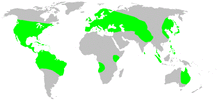| Ray spiders | |
|---|---|
 | |
| Wendilgarda, female | |
| Scientific classification | |
| Kingdom: | Animalia |
| Phylum: | Arthropoda |
| Subphylum: | Chelicerata |
| Class: | Arachnida |
| Order: | Araneae |
| Infraorder: | Araneomorphae |
| Family: | Theridiosomatidae Simon, 1881[1] |
| Diversity | |
| 19 genera, 131 species | |
 | |
The ray spiders (Theridiosomatidae) are a family of spiders first described by Eugène Simon in 1881.[2] They are most recognizable for their construction of cone-shaped webs.[3]
Genera
As of April 2019, the World Spider Catalog accepts the following genera:[1]
- Andasta Simon, 1895 – Seychelles, Malaysia, Sri Lanka
- Baalzebub Coddington, 1986 – Central America, Brazil, Australia, China
- Chthonopes Wunderlich, 2011 – Laos
- Chthonos Coddington, 1986 – Ecuador, Brazil, Peru
- Coddingtonia Miller, Griswold & Yin, 2009 – Malaysia, Laos
- Cuacuba Prete, Cizauskas & Brescovit, 2018
- Epeirotypus O. Pickard-Cambridge, 1894 – Mexico, Costa Rica
- Epilineutes Coddington, 1986 – Mexico, Brazil
- Karstia Chen, 2010 – China
- Menglunia Zhao & Li, 2012 – China
- Naatlo Coddington, 1986 – Central America, South America, Trinidad and Tobago
- Ogulnius O. Pickard-Cambridge, 1882 – South America, Caribbean, Panama, Asia
- Parogulnius Archer, 1953 – United States
- Plato Coddington, 1986 – South America, Trinidad
- Sinoalaria Zhao & Li, 2014 – China
- Tagalogonia Labarque & Griswold, 2014 – Philippines
- Theridiosoma O. Pickard-Cambridge, 1879 – South America, Africa, Oceania, North America, Asia, Central America, Jamaica
- Wendilgarda Keyserling, 1886 – Asia, São Tomé and Príncipe, Central America, Brazil, Mexico, Caribbean
- Zoma Saaristo, 1996 – China, Seychelles
Fossil species
- †Eoepeirotypus Wunderlich 2004 Baltic amber, Eocene
- †Eotheridiosoma Wunderlich 2004 Bitterfeld amber, Baltic amber, Eocene
- †Palaeoepeirotypus Wunderlich 1988 Dominican amber, Miocene
- †Umerosoma Wunderlich 2004 Baltic amber, Eocene
- †"Baalzebub" mesozoicum Penney 2014 - Vendée amber, France, Turonian[4] later considered to be stem-theridiosomatid[5]
See also
References
- ^ a b "Family: Theridiosomatidae Simon, 1881". World Spider Catalog. Natural History Museum Bern. Retrieved 2019-04-26.
- ^ Simon, E. (1881). Les arachnides de France. Tome cinquième, première partie.
- ^ Kaston, B.J. (1972). How to Know the Spiders. Pictured key nature series (3rd ed.). Dubuque, IA: Wm C. Brown Company Publishers. ISBN 9780697048981. OCLC 668250654.
- ^ "A fossil ray spider (Araneae: Theridiosomatidae) in Cretaceous amber from Vendée, France". Paleontological Contributions. 2014-12-01. doi:10.17161/pc.1808.15982. ISSN 1946-0279.
- ^ Magalhaes, Ivan L. F.; Azevedo, Guilherme H. F.; Michalik, Peter; Ramírez, Martín J. (February 2020). "The fossil record of spiders revisited: implications for calibrating trees and evidence for a major faunal turnover since the Mesozoic". Biological Reviews. 95 (1): 184–217. doi:10.1111/brv.12559. ISSN 1464-7931.
External links